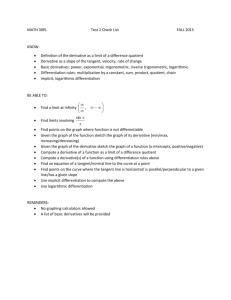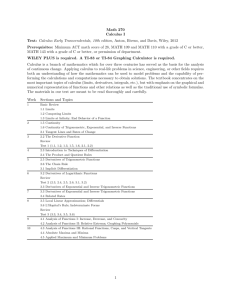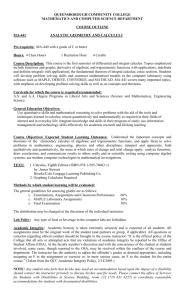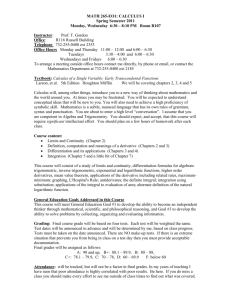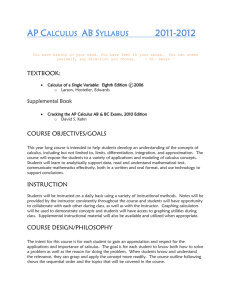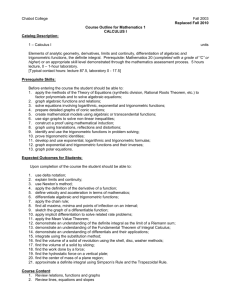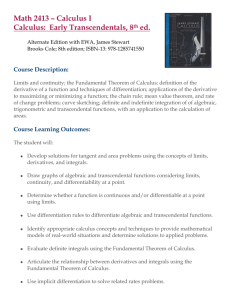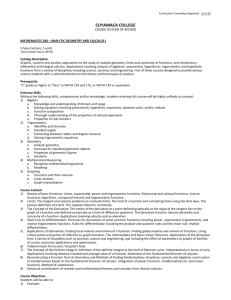Calculus I - Las Positas College
advertisement
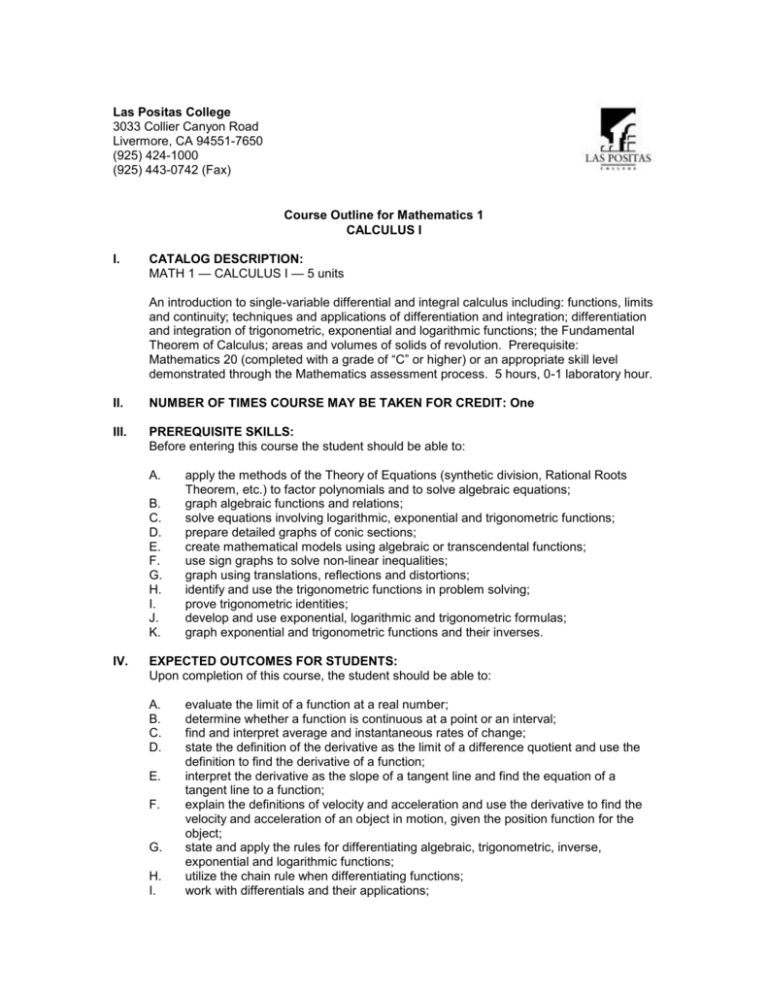
Las Positas College 3033 Collier Canyon Road Livermore, CA 94551-7650 (925) 424-1000 (925) 443-0742 (Fax) Course Outline for Mathematics 1 CALCULUS I I. CATALOG DESCRIPTION: MATH 1 — CALCULUS I — 5 units An introduction to single-variable differential and integral calculus including: functions, limits and continuity; techniques and applications of differentiation and integration; differentiation and integration of trigonometric, exponential and logarithmic functions; the Fundamental Theorem of Calculus; areas and volumes of solids of revolution. Prerequisite: Mathematics 20 (completed with a grade of “C” or higher) or an appropriate skill level demonstrated through the Mathematics assessment process. 5 hours, 0-1 laboratory hour. II. NUMBER OF TIMES COURSE MAY BE TAKEN FOR CREDIT: One III. PREREQUISITE SKILLS: Before entering this course the student should be able to: A. B. C. D. E. F. G. H. I. J. K. IV. apply the methods of the Theory of Equations (synthetic division, Rational Roots Theorem, etc.) to factor polynomials and to solve algebraic equations; graph algebraic functions and relations; solve equations involving logarithmic, exponential and trigonometric functions; prepare detailed graphs of conic sections; create mathematical models using algebraic or transcendental functions; use sign graphs to solve non-linear inequalities; graph using translations, reflections and distortions; identify and use the trigonometric functions in problem solving; prove trigonometric identities; develop and use exponential, logarithmic and trigonometric formulas; graph exponential and trigonometric functions and their inverses. EXPECTED OUTCOMES FOR STUDENTS: Upon completion of this course, the student should be able to: A. B. C. D. E. F. G. H. I. evaluate the limit of a function at a real number; determine whether a function is continuous at a point or an interval; find and interpret average and instantaneous rates of change; state the definition of the derivative as the limit of a difference quotient and use the definition to find the derivative of a function; interpret the derivative as the slope of a tangent line and find the equation of a tangent line to a function; explain the definitions of velocity and acceleration and use the derivative to find the velocity and acceleration of an object in motion, given the position function for the object; state and apply the rules for differentiating algebraic, trigonometric, inverse, exponential and logarithmic functions; utilize the chain rule when differentiating functions; work with differentials and their applications; Course Outline for Mathematics 1 CALCULUS I J. K. L. M. N. O. P. Q. R. S. T. U. V. V. use calculus-based methods to analyze functional behavior; sketch the graphs of algebraic, rational and transcendental functions using the methods of calculus; find all maxima, minima and points of inflection of a function; use implicit differentiation; evaluate the limit of a function at infinity; apply differentiation to solve related rate and optimization problems; apply the Mean Value Theorem; utilize Newton’s Method; evaluate a definite integral as the limit of a Riemann sum; apply the Fundamental Theorem of Integral Calculus; evaluate integrals by the method of substitution; find areas between curves and volumes of solids of revolution; use logarithmic differentiation. CONTENT: A. Limits 1. Left-hand limits and right-hand limits 2. Computing limits a. Numerically b. Graphically c. Algebraically 3. Limits of trigonometric functions 4. Limits at infinity B. Average and instantaneous rates of change C. Continuity 1. Definition of continuity 2. Continuity at a real number 3. Continuity on an interval 4. Discontinuous functions a. Types of discontinuities b. Removable discontinuities D. Intermediate Value Theorem E. Secant and tangent lines F. Average and instantaneous rates of change; velocity and acceleration G. Definition of the derivative as the limit of a difference quotient H. Interpretation of the derivative 1. Slope of a tangent line 2. Rate of change 3. Derivative as a function I. Differentiation formulas and techniques 1. Differentiation of constant-valued function 2. Power rule 3. Product rule 4. Quotient rule 5. Trigonometric functions 6. Chain rule 7. Implicit derivative 8. Higher-order derivatives J. Applications of differentiation 1. Rate of change 2. Related rates 3. Optimization K. Functional analysis 1. Mean Value Theorem 2. Critical numbers Page 2 Course Outline for Mathematics 1 CALCULUS I L. M. N. O. P. Q. R. S. T. U. V. W. X. Page 3 3. Maximum and minimum values (absolute and local) Curve sketching: algebraic, rational and trigonometric functions 1. First Derivative Test 2. Second Derivative Test 3. Test for Concavity and Points of Inflection 4. Extrema 5. Asymptotic behavior a. Limits at infinity b. Horizontal and vertical asymptotes Differentials and their applications Newton’s Method Antiderivatives Definite integral 1. Interpretation as area under a curve 2. Defined as limit of a Riemann Sum 3. Evaluation of a definite integral as the limit of a Riemann Sum Indefinite integrals Properties of definite and indefinite integrals Fundamental Theorem of Calculus Integration 1. As antidifferentiation 2. Method of substitution Applications of integration 1. Area under a curve 2. Area between curves 3. Volume of a solid of revolution Inverse functions 1. Differentiation of inverse functions Exponential functions 1. Differentiation 2. Integration Logarithmic functions 1. Differentiation 2. Logarithmic differentiation 3. Integration VI. METHODS OF INSTRUCTION: Any of these at the discretion of the instructor. A. Lecture B. Discussion C. Collaborative learning D. Student presentations E. Lab assignments F. Web- or CD-Rom-based tutorials VII. TYPICAL ASSIGNMENTS: A. Homework 1. Homework should be assigned from the text and should include a sufficient number and variety of problems to develop both skill and conceptual understanding. A typical assignment should that an average student 1 to 2 hours for each hour in class. B. Collaborative learning 1. Collaborative learning, done in small groups of 2-4 students, can be used to introduce new concepts, build skills, or teach problem solving. Students may be asked to present their results on the board. Course Outline for Mathematics 1 CALCULUS I Page 4 2. C. Example collaborative learning assignment: Have each group solve a curvesketching problem and then present their work to the rest of the class, explaining the process they used and their results. Laboratory assignments 1. Lab assignments can be used to reinforce fundamental concepts and skills or to explore certain concepts in more depth than is possible in-class. They may be designated for individual or group work. Lab assignments are completed in the Open Math Lab where students have access to assistance with the assignments. 2. Example lab assignment: Sketch a family of curves and comment on how changes in the constant coefficients affect (a) locations of extrema and points of inflection and (3) intervals on which the function is increasing/decreasing, concave upward/downward. VIII. EVALUATION: A. Methods of evaluation 1. Examinations 2. Comprehensive final examination 3. Laboratory assignments 4. Any of all of the following at the discretion of the instructor B. Homework 1. Quizzes (announced or unannounced, in-class or take home) 2. Collaborative group activities 3. Projects C. Frequency of evaluation 1. Recommend minimum of four exams plus the final 2. Homework should be assigned for each section covered 3. Recommend minimum of eight laboratory assignments over the semester 4. Number of quizzes and collaborative activities are at the discretion of the instructor IX. TYPICAL TEXTS: A. James Stewart. Calculus. 5th edition. Belmont, CA: Brooks/Cole-Thomson Learning, 2003. B. Howard Anton, Bivens, Irl and Davis, Stephen. Calculus: Early Transcendentals, Single and Multivariable. 8th Edition. New York: John Wiley & Sons, Inc., 2005. C. Ron Larson, Hostetler, Robert P., and Edwards, Bruce H. Calculus. 8th Edition. Boston, MA: Houghton Mifflin Company, 2006. X. OTHER MATERIALS REQUIRED OF STUDENTS: Graphing calculator Creation Date: 01/94 Revision Date: 02/95, 11/02, 10/06 Date Approved by Curriculum Committee: 11/08/06 Effective Date: Fall 2007


